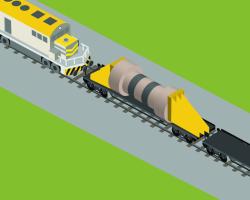Category of Content
Siting Experience Documents Only
Publication Date
Subject Matter
Keywords
Criticality Consequence Analysis Involving Intact PWR SNF in a Degraded 21 PWR Assembly Waste Package
Criticality Consequence Analysis Involving Intact PWR SNF in a Degraded 21 PWR Assembly Waste Package
Intact and Degraded Mode Criticality Calculations for the Codisposal of ATR Spent Nuclear Fuel in a Waste Package
Intact and Degraded Mode Criticality Calculations for the Codisposal of ATR Spent Nuclear Fuel in a Waste Package
Technical Bases for Extended Dry Storage of Spent Nuclear Fuel
Technical Bases for Extended Dry Storage of Spent Nuclear Fuel
Independent spent fuel storage installations (ISFSIs) are currently licensed for 20 years. However, delays in developing permanent spent fuel disposal capability require continued ISFSI storage beyond the 20-year term. This report provides a technical basis for demonstrating the feasibility of extended spent fuel storage in ISFSIs.
EBS Radionuclide Transport Abstraction
EBS Radionuclide Transport Abstraction
The purpose of this report is to develop and analyze the Engineered Barrier System (EBS) Radionuclide Transport Abstraction Model, consistent with Level I and Level II model validation, as identified in Technical Work Plan for: Near-Field Environment: Engineered Barrier System: Radionuclide Transport Abstraction Model Report (BSC 2006 [DIRS 177739]). The EBS Radionuclide Transport Abstraction (or RTA) is the conceptual model used in the Total System Performance Assessment (TSPA) to determine the rate of radionuclide releases from the EBS to the unsaturated zone (UZ).
Transportation Institutional Issues Involving the U.S. Department of Energy's Civilian Radioactive Waste Management Program: The Post Yucca Mountain Years
Transportation Institutional Issues Involving the U.S. Department of Energy's Civilian Radioactive Waste Management Program: The Post Yucca Mountain Years
This 10th anniversary update to the original archive adds several sections that cover relevant topics since 2010. Some of the new topics include the Blue Ribbon Commission on America's Nuclear Future, consent-based siting, tribal engagement, shutdown site visits, and industry interests. Much like the first publication, the purpose of this update is to make it easier for new personnel to learn about what came before them in the hope that this knowledge gives them a greater chance of success.

